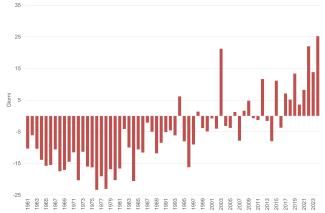Panel 1
Piero Fraschetti, Francesca Lena, Walter Perconti, Emanuela Piervitali, Giulio Settanta
The indicator describes the trend in extreme heat events in Italy, specifically representing the number of days with a minimum daily air temperature exceeding 20 °C. In 2025, an increase of approximately 25.2 tropical nights was observed compared to the climatological average for the 1991–2020 reference period.
The occurrence of extreme temperature events and the presence of significant trends are assessed through the analysis of absolute minimum and maximum daily air temperature values. Specifically, the indicator “tropical nights”, as defined by the CCL/CLIVAR Working Group on Climate Change Detection, refers to the number of days when the daily minimum air temperature remains above 20 °C.
The annual time series of the average number of tropical nights, expressed as the deviation from a climatological baseline, enables the estimation of the frequency of extreme heat events and the assessment of significant trends over time.
The indicator is not directly linked to any regulatory or legislative framework
Panel 2
https://scia.isprambiente.it;
APAT-OMS, 2007, Cambiamenti climatici ed eventi estremi: rischi per la salute in Italia, Rapporti 77/2007
ISPRA, 2022, I normali climatici 1991-2020 di temperatura e precipitazione in Italia; Stato dell'Ambiente 99/2022
ISPRA, 2018, Variazioni della temperatura in Italia: estensione della base dati e aggiornamento della metodologia di calcolo; Stato dell’ambiente 81/2018;
ISPRA, 2016, Controlli di qualità delle serie di temperatura e precipitazione; Stato dell'Ambiente 66/2016
ISPRA, 2015, Valori climatici normali di temperatura e precipitazione in Italia; Stato dell'Ambiente 55/2015
ISPRA, 2014, Focus su "Le città e la sfida ai cambiamenti climatici"; Stato dell'Ambiente 54/2014
ISPRA, 2013, Variazioni e tendenze degli estremi di temperatura e precipitazione in Italia; Stato dell'Ambiente 37/2013
ISPRA, 2012, Elaborazione delle serie temporali per la stima delle tendenze climatiche; Stato dell'Ambiente 32/2012
Peterson T.C ., Folland C , Gruza G, Hogg W, Mokssit A e Plummer N., 2001, Report on the activities of the Working Group on Climate Change Detection and Related Rapporteurs 1998-2001. World Meteorological Organization, Rep. WC DMP-47, WMO -TD 1071, Geneva, Switzerland, 143 pp.;
SNPA, 2025, Il clima in Italia nel 2024; Report ambientali SNPA n. 44/2025
Toreti A. e Desiato F., 2007, Changes in temperature extremes over Italy in the last 44 years, Int. J. Climatology, DO I 10.1002/joc.1576.
Improvements in the estimation of tropical nights in Italy could stem from expanding the indicator calculation system to include additional sources of raw temperature data, in order to enhance the availability of historical temperature series that meet the criteria of duration, continuity, and completeness of time series.
Data quality assessment
ISPRA (Istituto Superiore per la Protezione e la Ricerca Ambientale)
SCIA – Sistema nazionale per l’elaborazione e diffusione di dati climatici (https://scia.isprambiente.it)
Italy
1961-2024
Indicator assessment
To determine whether a given calendar day qualifies as a tropical night, the daily minimum air temperature is compared with the threshold of 20°C. This requires access to validated daily minimum temperature data. The SCIA system (National System for the Processing and Dissemination of Climate Data) processes raw meteorological data and outputs a daily minimum temperature value, which is accepted as valid only if it passes quality control checks. If the daily minimum temperature is validated, it is compared with the 20°C threshold to establish whether the day is classified as a tropical night. The annual indicator value is calculated as the total number of tropical nights recorded in a given year. This annual value is considered valid only if at least 75% of the daily data for that year are available and validated. The climatological baseline used to calculate anomalies has been updated to the most recent 30-year reference period, 1991–2020. This choice aligns with the latest recommendations from the World Meteorological Organization (WMO), which advises updating climatological baselines every ten years for operational climatology purposes.
In 2024, an increase of about 25.2 tropical nights was observed compared to the average value calculated for the reference thirty-year period 1991-2020.
In the last 10 years, tropical nights have consistently been higher than the reference thirty-year period 1991-2020, with the exception of 2016. Since the main international climate change strategies and political programs aim to counteract the ongoing warming of the climate system, the evaluation of an unfavorable trend and the assignment of the corresponding icon can be considered in terms of deviation from this goal.

The time series of annual average anomalies for the number of tropical nights in Italy indicates that 2024, with an increase of approximately 25.2 nights compared to the average value calculated for the reference thirty-year period (1991-2020), ranks first among the hottest years in the entire series (Figure 1